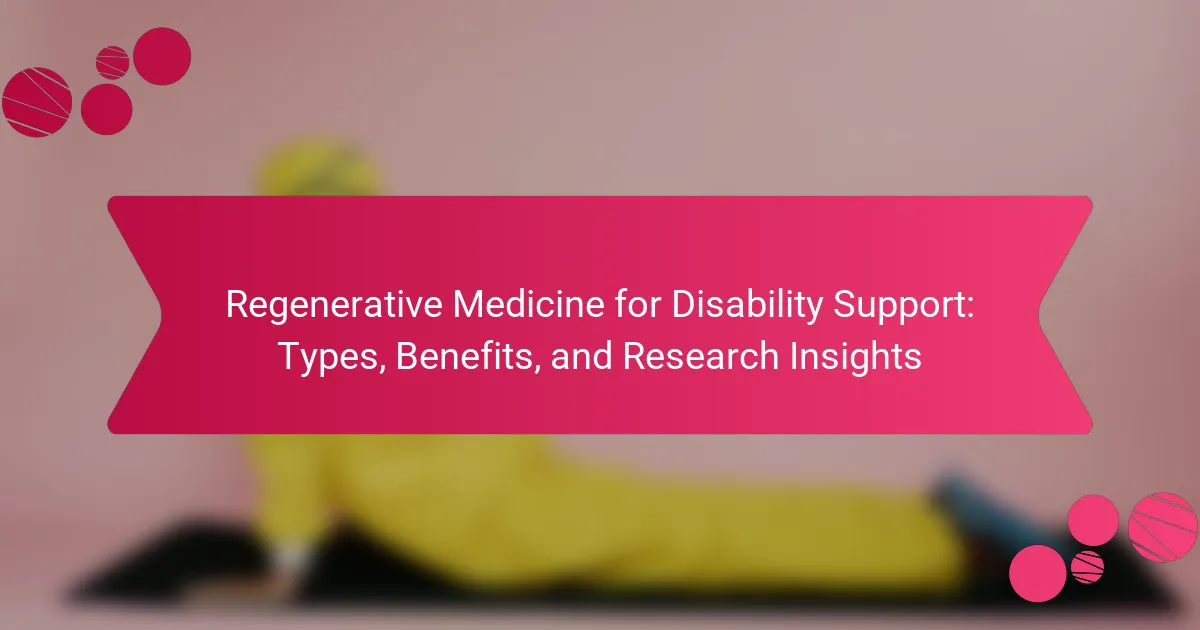Regenerative medicine significantly enhances support for individuals with disabilities by promoting healing and functional recovery. This article explores various therapies, including stem cell treatments and tissue engineering, and their benefits in improving mobility and quality of life. It also highlights recent research insights and the potential for personalized treatment options. Understanding these advancements can empower patients and caregivers in navigating disability management.
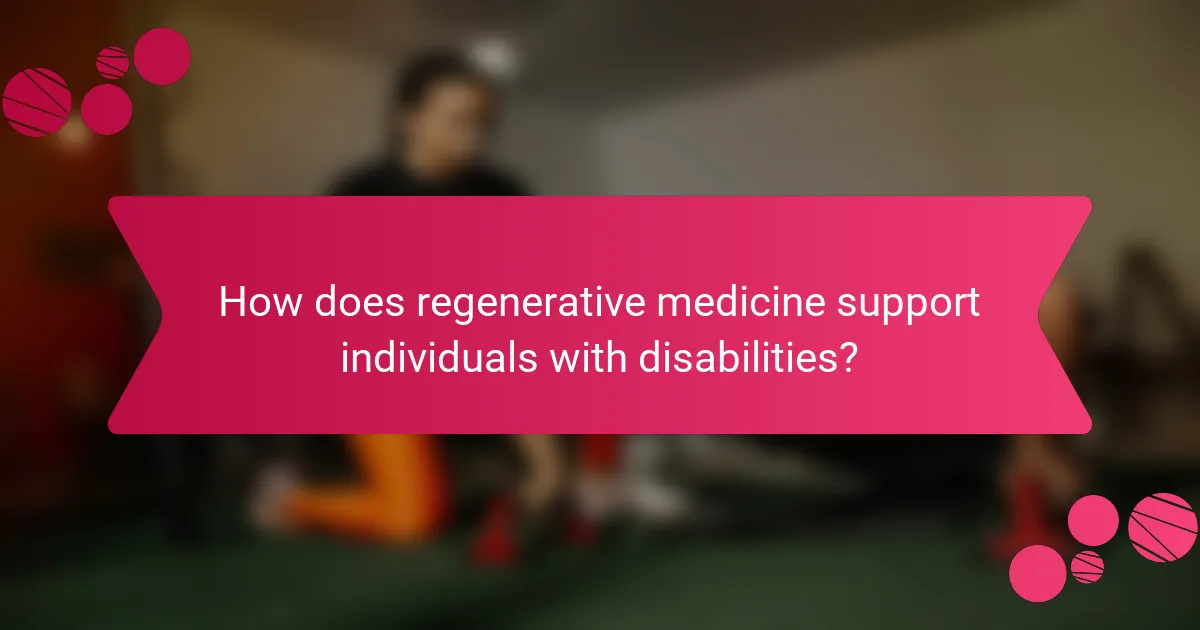
How does regenerative medicine support individuals with disabilities?
Regenerative medicine significantly enhances support for individuals with disabilities by promoting healing and functional recovery. Various therapies, including stem cell treatments and tissue engineering, aim to restore damaged tissues and improve mobility. Research indicates that regenerative approaches can lead to improved quality of life and increased independence for patients. For instance, studies show that stem cell therapies can reduce symptoms in conditions like spinal cord injuries and neurodegenerative diseases. As a result, regenerative medicine is a promising avenue for advancing disability support.
What are the core principles of regenerative medicine?
Regenerative medicine focuses on repairing or replacing damaged tissues and organs to improve function. Core principles include cell therapy, tissue engineering, and gene therapy. These approaches aim to harness the body’s natural healing processes and promote regeneration. Research continues to explore innovative applications, enhancing disability support through improved mobility and quality of life.
Why is regenerative medicine important for disability support?
Regenerative medicine is crucial for disability support as it offers innovative treatments that restore function and improve quality of life. This field utilizes techniques like stem cell therapy and tissue engineering to repair or replace damaged tissues. Research shows regenerative approaches can significantly enhance mobility and reduce pain in individuals with disabilities. Furthermore, ongoing studies are exploring new applications, potentially expanding treatment options for various conditions.
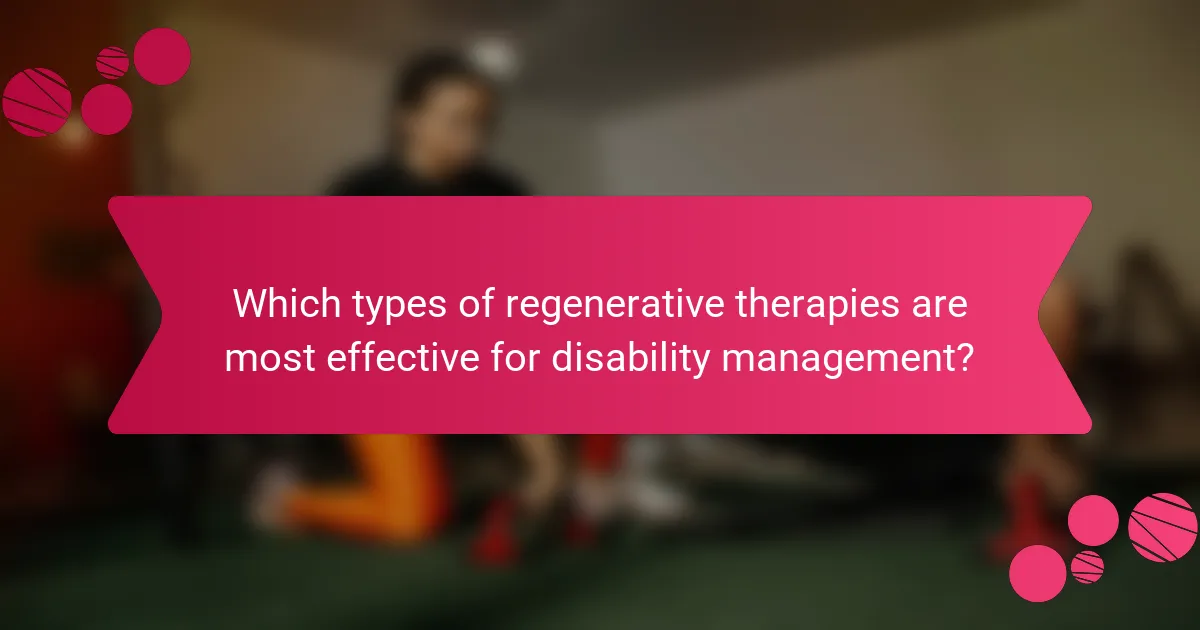
Which types of regenerative therapies are most effective for disability management?
Regenerative therapies such as stem cell therapy, platelet-rich plasma (PRP) therapy, and tissue engineering are effective for disability management. These therapies promote healing and regeneration of damaged tissues, improving function and quality of life.
Stem cell therapy uses stem cells to repair or replace damaged cells, showing promise in conditions like spinal cord injuries and neurodegenerative diseases. PRP therapy utilizes concentrated platelets from the patient’s blood to enhance healing, particularly in musculoskeletal injuries. Tissue engineering combines cells and biomaterials to create functional tissues, offering solutions for severe injuries and degenerative diseases.
Research indicates that these therapies can lead to significant improvements in mobility and pain reduction, enhancing overall disability management outcomes. Continued studies are essential to optimize protocols and establish long-term efficacy.
How do stem cell therapies contribute to recovery?
Stem cell therapies significantly enhance recovery by promoting tissue regeneration and reducing inflammation. They facilitate healing in various conditions, including spinal cord injuries and degenerative diseases. Research shows stem cells can differentiate into specialized cells, aiding in repairing damaged tissues. Moreover, they release growth factors that can stimulate the body’s natural healing processes. Current studies focus on optimizing stem cell sources and delivery methods to maximize therapeutic benefits.
What role does tissue engineering play in rehabilitation?
Tissue engineering significantly enhances rehabilitation by creating biological substitutes that restore, maintain, or improve tissue function. This approach enables the development of scaffolds that support cell growth and tissue regeneration, leading to improved recovery outcomes for individuals with disabilities. Research indicates that tissue-engineered solutions can reduce healing time and enhance the quality of life by addressing specific injuries or degenerative conditions. For example, advancements in stem cell therapy and bioprinting are paving the way for personalized rehabilitation strategies that cater to individual needs.
Which advanced therapies are emerging in 2025?
Emerging advanced therapies in regenerative medicine for disability support in 2025 include stem cell therapy, gene editing, and tissue engineering. These approaches aim to restore function and improve quality of life for individuals with disabilities.
Stem cell therapy shows promise in repairing damaged tissues and promoting regeneration. Gene editing technologies, like CRISPR, offer potential to correct genetic disorders causing disabilities. Tissue engineering focuses on creating biological substitutes to restore damaged organs or tissues.
Research insights indicate that these therapies may significantly reduce disability-related complications and enhance recovery. Ongoing clinical trials are crucial for validating their effectiveness and safety in diverse populations.
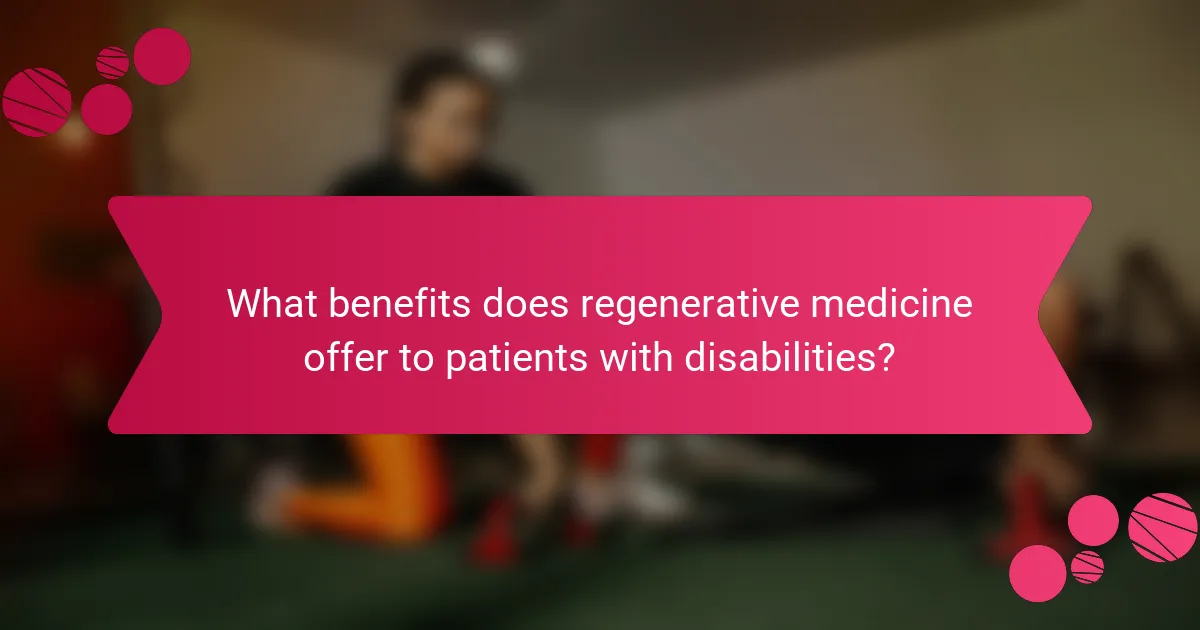
What benefits does regenerative medicine offer to patients with disabilities?
Regenerative medicine offers significant benefits to patients with disabilities by promoting healing and restoring function. This field utilizes advanced techniques such as stem cell therapy and tissue engineering to repair damaged tissues and organs. Patients often experience improved mobility, reduced pain, and enhanced quality of life. Research indicates that regenerative approaches can lead to long-term recovery and increased independence for individuals with various disabilities. The unique ability of regenerative medicine to harness the body’s natural healing processes sets it apart from traditional treatments.
How does regenerative medicine enhance mobility and function?
Regenerative medicine enhances mobility and function by repairing damaged tissues and promoting healing. This field utilizes stem cells, growth factors, and tissue engineering to restore physical capabilities. Research indicates significant improvements in joint function and reduced pain for patients with various disabilities. Techniques like platelet-rich plasma therapy and stem cell injections have shown promising results in clinical trials, demonstrating the potential for increased independence and quality of life.
What psychological benefits can patients experience?
Patients can experience enhanced emotional well-being, increased self-esteem, and improved social interactions through regenerative medicine. These psychological benefits stem from the physical improvements in mobility and functionality that boost confidence. Research indicates that patients often report reduced anxiety and depression levels post-treatment. Regenerative therapies can foster a sense of hope and empowerment, significantly impacting overall mental health.
How do these therapies impact quality of life?
Regenerative medicine therapies significantly enhance quality of life for individuals with disabilities. They improve mobility, reduce pain, and promote healing, leading to greater independence. Research indicates these therapies can increase functional abilities and psychological well-being, fostering a more active lifestyle. For example, stem cell treatments have shown promising results in restoring motor function in spinal cord injury patients.
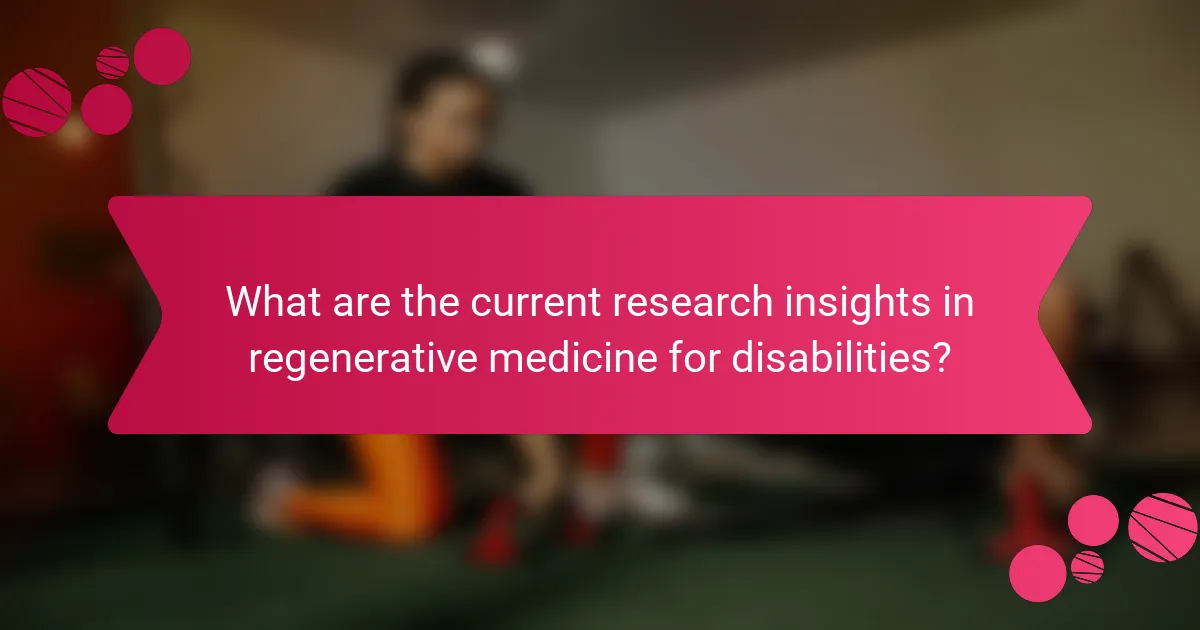
What are the current research insights in regenerative medicine for disabilities?
Current research in regenerative medicine for disabilities focuses on advanced therapies, including stem cell treatments and tissue engineering. These approaches aim to restore function and improve quality of life for individuals with disabilities. Recent studies highlight the potential of induced pluripotent stem cells (iPSCs) in generating patient-specific tissues, which can lead to personalized treatment options. Additionally, breakthroughs in 3D bioprinting are enabling the creation of functional tissues that can be used for transplantation. As a result, regenerative medicine continues to evolve, offering promising insights for future therapies targeting various disabilities.
Which studies are leading in 2025?
In 2025, leading studies in regenerative medicine for disability support focus on stem cell therapies, tissue engineering, and gene editing. These studies aim to enhance recovery and improve quality of life for individuals with disabilities. Key research highlights include advancements in personalized medicine and the integration of bioprinting technologies. As a result, these innovations may significantly reduce rehabilitation times and enhance functional outcomes.
How is technology shaping future research directions?
Technology is revolutionizing regenerative medicine research by enhancing treatment methods and patient outcomes. Advanced techniques like 3D bioprinting and gene editing are paving new paths for developing therapies that support disabilities. Research focuses on stem cell applications, tissue engineering, and personalized medicine, yielding promising results. For instance, stem cell therapies have shown potential in restoring mobility for spinal cord injury patients. Emerging technologies are also improving data collection and analysis, fostering collaboration across disciplines. As a result, the future of regenerative medicine is set to transform disability support significantly.
What are the challenges faced in clinical trials?
Clinical trials in regenerative medicine face several challenges that can hinder their progress. Key issues include patient recruitment difficulties, high costs, regulatory hurdles, and variability in treatment responses.
Recruitment challenges arise due to limited patient populations and stringent eligibility criteria. High costs stem from the need for advanced technologies and long study durations. Regulatory hurdles involve navigating complex approval processes, which can delay trials. Additionally, variability in treatment responses complicates data analysis, making it harder to draw definitive conclusions.
These challenges collectively impact the timeline and success rate of clinical trials in regenerative medicine. Addressing them is crucial for advancing research and improving disability support outcomes.
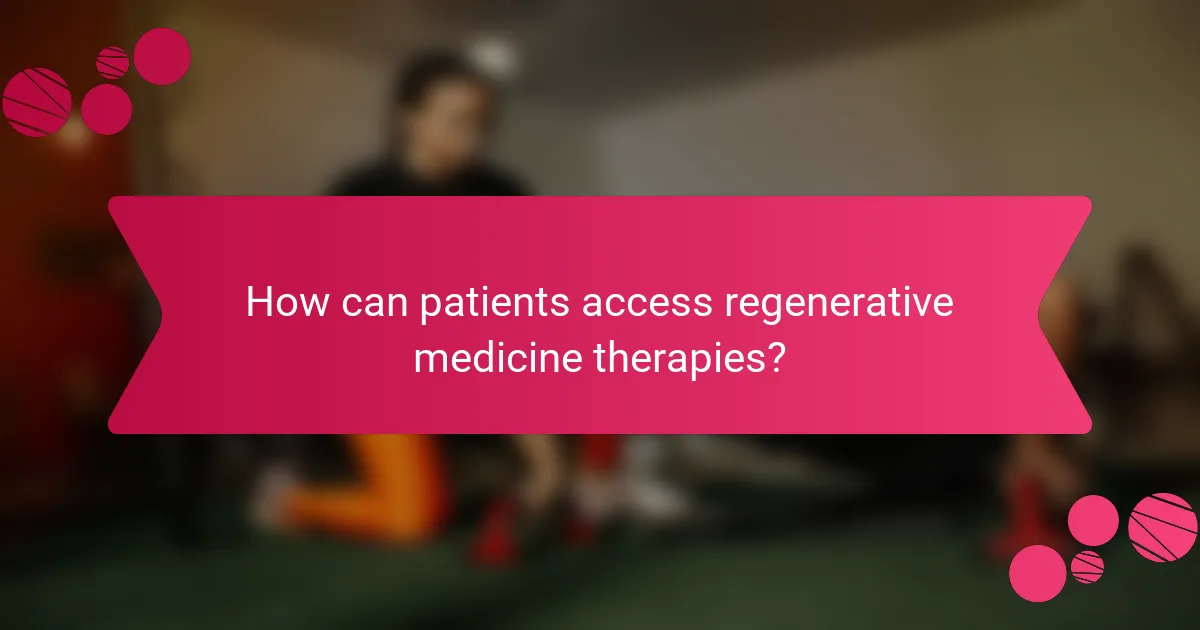
How can patients access regenerative medicine therapies?
Patients can access regenerative medicine therapies through specialized clinics, research institutions, and medical professionals offering innovative treatments. Many facilities provide consultations to determine eligibility and treatment options. Clinical trials are another avenue, allowing patients to participate in cutting-edge research. Some therapies may require referrals from healthcare providers to ensure proper evaluation and care.
What factors should patients consider when choosing a treatment center?
Patients should consider several factors when choosing a treatment center for regenerative medicine. Key aspects include the center’s expertise in specific conditions, available treatment options, and the qualifications of the medical team.
Additionally, patients should evaluate the center’s research involvement and clinical outcomes. The center’s reputation and patient reviews can provide insights into the quality of care. Accessibility and insurance coverage are also crucial factors that influence the decision.
Which insurance options cover these therapies?
Many insurance options cover regenerative medicine therapies, including private health insurance, Medicare, and Medicaid. Coverage varies by plan and state. Research suggests that policies increasingly recognize the benefits of these therapies for disability support. Some insurers may require prior authorization or specific documentation to approve treatments.
How can patients advocate for their treatment needs?
Patients can advocate for their treatment needs by actively engaging with healthcare providers and staying informed about regenerative medicine options. They should research available therapies, understand their benefits, and communicate openly about their specific conditions and treatment goals. Building a support network can also empower patients to voice their needs effectively. Additionally, participating in clinical trials can provide access to cutting-edge treatments while contributing to research insights in regenerative medicine.
What are best practices for maximizing therapy effectiveness?
To maximize therapy effectiveness in regenerative medicine for disability support, focus on personalized treatment plans. Tailor interventions based on individual needs and conditions. Regularly assess progress and adjust therapies as necessary. Engage patients in their treatment decisions to enhance motivation and adherence. Foster a multidisciplinary approach, incorporating various specialists for comprehensive care.
